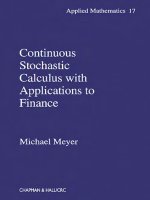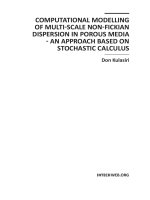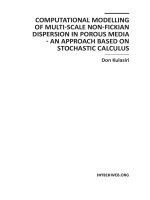Stochastic Calculus
Bạn đang xem bản rút gọn của tài liệu. Xem và tải ngay bản đầy đủ của tài liệu tại đây (321.07 KB, 16 trang )
23
Stochastic Calculus
23.1 INTRODUCTION
(i) The last couple of chapters were heavily mathematical with not much reference to option
theory. Brownian motion was investigated in some detail and we developed a form of calculus
which could be used to analyze this process. We defined the Ito integral
T
0
a
t
dW
t
, which was
constructed to be a martingale, and we derived the following three explicit results from first
principles:
T
0
dW
t
= W
T
;
T
0
W
T
dW
t
=
1
2
W
2
T
−
1
2
T ;
T
0
(dW
t
)
2
= T (23.1)
The second and third results were rather surprising and reflect the fact that the quadratic varia-
tion of Brownian motion is equal to T, and not zero as it would be for a differentiable function.
(ii) The reader will be disappointed (or perhaps relieved) to learn that we cannot go very much
further in deriving explicit integrals. In classical calculus, virtually any continuous function can
be differentiated from first principles, i.e. putting x → x + δx as the argument of a function,
expanding and then setting O[δt
2
] → 0. Not all functions can be integrated analytically; but
Riemann integration can be equated to reverse differentiation, so that a large library of standard
integrals has been established. Differentiation with respect to time has no meaning in stochastic
calculus, so this approach is not available. The reader’s first reaction to this news must be to
wonder whether it was worth plowing through all the stuff in the last two chapters just to derive
a calculus which is so puny that it can only manage three integrals. But thanks to Ito’s lemma
which is discussed next, some powerful calculation techniques do emerge.
(iii) This brings us to an important definitional point: the whole motivation for these chapters
on stochastic theory is that we believe that a stock price movement can be written as δS
t
=
a(S
t
, t)δt + b( S
t
, t)δW
t
. Presumably, in the limit of infinitesimal time intervals, this could
be written as the differential equation dS
t
= a(S
t
, t)dt + b( S
t
, t)dW
t
. The reader might have
noticed that books on stochastic theory (including this one) have sections entitled Stochastic
Differential Equations, which deal with equations of this type. Yet in the last chapter it was
emphasized that differential calculus does not apply to Brownian motion; so what’s going on?
Let us ignore the a
t
δt term for the moment, as this is not where the difficulty arises, and
write for b(S
t
, t). The position is summarized as follows:
(A) The intuitive relationship δS
t
= b
t
δW
t
is perfectly respectable: a small Brownian motion
drives a small movement in S
t
.
(B) If you want to make δS
t
and δW
t
very, very, very small and write this as dS
t
= b
t
dW
t
,
that’s OK. You can even write dS
t
/dW
t
= b
t
, which is discussed in the next subsection.
(C) You can certainly rewrite this relationship as S
T
− S
0
=
0
T
dS
t
=
0
T
b
t
dW
t
.Wehave,
after all, just spent a chapter defining exactly what this integral means.
(D) But it is absolutely forbidden to put
0
T
b
t
dW
t
=
T
0
b
t
dW
t
dt
dt.
23 Stochastic Calculus
The punch-line is that when we see the differential equation dS
t
= a
t
dt + b
t
dW
t
, what is
really meant is
S
T
− S
0
=
0
T
a
t
dt +
0
T
b
t
dW
t
where the first integral is a Riemann integral and the second integral is the Ito integral which
was defined in Chapter 22. The differential form is mere shorthand and should immediately
be hidden if a serious mathematician drops by. The justification for this shorthand is that first,
it is a simple and intuitive representation of a process and second, everybody else does it. In
this spirit of imprecision, we can state that dS
t
= b
t
dW
t
is a martingale.
(iv) The next section uses the properties of differentials extensively, so at the risk of belaboring
the obvious, it is worth reviewing when differential calculus can be used and when not. A
stock price S
t
is stochastic, as is the price of the derivative of the stock f (S
t
). But despite
the fact that they are both stochastic, f (S
t
) is a well-behaved, differentiable function of S
t
.In
fact, ∂ f (S
t
)/∂ S
t
, is just the delta of the derivative. Similarly, ∂ f (S
t
)/∂t is well defined, even
though S
t
behaves randomly over an infinitesimal time interval dt. The reason is that the partial
differential is defined as the limit of δ f
t
divided by δt while holding S
t
constant. Although
the partial derivatives of f (S
t
) with respect to both S
t
and t are meaningful, dS
t
/dt does not
make the grade. It is impossible to attach a meaning to this when we have no idea whether the
next move in S
t
will be up or down, or by how much. Similarly, d f (S
t
)/dt is meaningless; this
seems a little surprising since the partial derivative was well behaved, but remember that the
total derivative does not hold S
t
constant over the infinitesimal time interval. Finally, although
d f (S
t
, t)/dt is not allowed, a close relative defined by
A f (S
t
, t) = lim
δ
t→0
E[ f (S
t
+ δS, t + δt) | F
t
] − f (S
t
, t)
δt
does have a respectable place in stochastic calculus. We revisit this in Section 23.8 .
23.2 ITO’S TRANSFORMATION FORMULA (ITO’S LEMMA)
(i) In general, a small increment in the price of a derivative may be given by a Taylor expansion
as follows:
δ f (S
t
, t) =
∂ f
t
∂t
δt +
∂ f
t
∂ S
t
δS
t
+
1
2
∂
2
f
t
∂ S
2
t
(δS
t
)
2
+
1
2
∂
2
f
t
∂t
2
(δt)
2
+
1
2
∂
2
f
t
∂ S∂t
(δS
t
)(δt) +···
In the limit of infinitesimal δt we would expect to throw away all terms higher than the first in
δt or δW
t
. However, if the stock price can be written dS
t
= a(S
t
, t)dt + b(S
t
, t)dW
t
, then the
third term in the above Taylor expansion will contain a term of the general form A
t
(dW
t
)
2
,or
in its integral form
T
0
A
t
(dW
t
)
2
= lim
δ
N →∞;
δ
t→0
N
i=1
A
i
(W
i
− W
i−1
)
2
This is Brownian quadratic variation, which unlike an analytic quadratic variation, does not
vanish to zero in the limit. (dW
t
)
2
is just not small enough to ignore in the Taylor expansion,
260
23.3 STOCHASTIC INTEGRATION
and in the limit of mean square convergence, we need to make the replacement (dW
t
)
2
→ dt
which was explained in Section 22.2(ii). Our Taylor expansion was of course written in terms of
(δS
t
)
2
, which leads to additional terms a
2
(dt)
2
and ab dS
t
dt, but these can be safely dropped
as they are O[(δt)
2
] and O[(δt)
3/2
].
(ii) Ito’s Lemma: The arguments in the last section have been couched in terms of a derivative
which is a function of a stock price. The conclusions apply more generally to any function of
a Brownian motion. For future reference, the results can be stated as follows.
If a stochastic variable, driven by a Brownian motion, follows the process
dx
t
= a (x
t
, t)dt + b (x
t
, t)dW
t
Then a differentiable function of x
t
follows a process which may equivalently be written in
either differential or integral form:
d f
t
=
∂ f
t
∂t
dt +
∂ f
t
∂x
t
dx
t
+
1
2
∂
2
f
t
∂x
2
t
(dx
t
)
2
=
∂ f
t
∂t
dt +
∂ f
t
∂x
t
dx
t
+
1
2
b
2
t
∂
2
f
t
∂x
2
t
dt
f
T
− f
0
=
T
0
∂ f
t
∂t
+ a
t
∂ f
t
∂x
t
+
1
2
b
2
t
∂
2
f
t
∂x
2
t
dt +
T
0
b
t
∂ f
t
∂x
t
dW
t
(23.2)
Remember that from the definition of an Ito integral, the last term of this second equation is a
martingale.
Ito’s lemma describes the stochastic process followed by f
t
, when f
t
is a function of a
stochastic process x
t
, which in turn is a function of the Brownian motion W
t
. A simplified
form of the lemma connecting f
t
and W
t
directly is obtained by putting a
t
= 0 and b
t
= 1:
f
T
− f
0
=
T
0
1
2
∂
2
f
t
∂W
2
t
dt +
T
0
∂ f
t
∂W
t
dW
t
(23.3)
23.3 STOCHASTIC INTEGRATION
At the beginning of this chapter it was observed that a stochastic integral cannot be considered
the reverse of a stochastic differential with respect to time, simply because the latter does
not exist. The result is that stochastic calculus can never build up the battery of standard
integrals possessed by analytical calculus. In fact, the store of standard results is so poor that
any insights are gratefully received. Ito’s lemma confirms in a very simple manner a couple
of the results we derived from first principles and gives us a procedure for integrating by
parts.
(i) Using equation (23.3), let f
t
= W
t
. Straightforward substitution gives
f
T
− f
0
= W
t
=
2
0
dW
t
which is the simplest integral, derived from first principles in Section 22.2(i).
261
23 Stochastic Calculus
(ii) A slightly more complex integral, derived in Section 22.2(iii), is obtained by putting f
t
= W
2
t
.
Again, substituting this in equation (23.3) gives
f
T
− f
0
= W
2
T
=
T
0
dt +
T
0
2W
t
dW
t
or
T
0
W
t
dW
t
=
1
2
W
2
T
−
1
2
T
(iii) Let x
t
= W
T
and f
t
= x
t
g(t) where g(t) is not dependent on x
t
, i.e. is non-stochastic. Then
equation (23.2) becomes
f
T
− f
0
= W
T
g(t) =
T
0
x
t
∂g(t)
∂t
dt +
T
0
g(t)dW
t
which immediately gives a stochastic form of integration by parts
T
0
g(t)dW
t
= W
T
g(T ) −
T
0
∂g(t)
∂t
W
t
dt (23.4)
23.4 STOCHASTIC DIFFERENTIAL EQUATIONS
(i) The simplest stochastic differential equation (SDE) of interest in option theory has constant
coefficients:
dx
t
= a dt + σ dW
t
which may be simply integrated to give
x
T
− x
0
= aT + σ W
T
From this very simple expression for x
T
, it is clear that
E
[
x
T
]
= x
0
+ aT and var
[
x
T
]
= σ
2
T
(ii) Stock Price Distribution: The most frequently used SDE for a stock price movement, which
underlies Black Scholes analysis, is the following:
dS
t
= µS
t
dt + σ S
t
dW
t
µ, σ constant
Let f
t
= ln S
t
; then equation (23.2) (Ito’s lemma) becomes
f
T
− f
0
− ln
S
T
S
0
=
T
0
µ −
1
2
σ
2
dt +
2
0
σ dW
t
=
µ −
1
2
σ
2
T + σ W
T
or
S
T
= S
0
e
(
µ−
1
2
σ
2
)
T +σ W
T
which is the well-known result of equation (3.7). The expectation and variance for S
T
were
found explicitly in Section 3.2 by plugging in the explicit normal distribution and slogging
through the integral. We are now able to achieve the same result with a lighter touch by using
262
23.4 STOCHASTIC DIFFERENTIAL EQUATIONS
Ito’s lemma. From the last result
E
S
T
S
0
= e
(µ−
1
2
σ
2
)T
E[e
σ W
T
] (23.5)
Define a new variable y
t
= e
σ W
t
and use equation (23.3) to give
y
T
− y
0
=
T
0
1
2
σ
2
y
t
dt +
T
0
σ y
t
dW
t
Both of the integrals in this equation contain random variables. Take the expectation at time
zero of the equation, writing E
[
y
t
|
F
0
]
= Y
t
, and note that the expected value of the Ito
integral is zero (martingale property):
Y
T
− Y
0
=
T
0
1
2
σ
2
Y
t
dt
The random variables have been eliminated from this equation by taking time zero expectations;
the solution is Y
T
= e
1
2
σ
2
T
which can be verified by substituting back in the last equation.
Substituting this solution back in equation (23.5) gives
E
S
T
S
0
= e
µ T
Precisely the same technique, using an intermediate variable, allows us to write
E
S
T
S
0
2
= e
2
(
µ−
1
2
σ
2
)
T
E[e
2σ W
T
] = e
(
2µ+σ
)
T
giving a variance
var
S
T
S
0
= E
S
T
S
0
2
− E
2
S
T
S
0
= e
2µT
(e
σ
2
T
− 1)
From the equation for ln S
t
/S
0
at the beginning of this subsection, it is clear that
var[ln S
T
/S
0
] = σ
2
T precisely. We may, however, make the approximation var[S
t
/S
0
] ≈ σ
2
δt
for small δt, by expanding the full expression to first order in δt.
(iii) In the last subsection we looked at the SDE with constant µ and σ . Suppose these parameters
were functions of S
t
and t: our results leading to equation (24.3) would simply become
S
T
= S
0
exp
T
0
µ(S
t
, t) −
1
2
σ
2
(S
t
, t)
dt +
T
0
σ (S
t
, t)dW
t
(iv) An Interesting Martingale: As a further exercise and because we need the result in the next
chapter, consider the process
dx
t
=−
1
2
φ
2
t
dt − φ
t
dW
t
Define ξ
t
= e
x
t
and use Ito’s lemma to give
ξ
T
− ξ
0
=−
T
0
φ
t
ξ
t
dW
t
263
23 Stochastic Calculus
or in differential shorthand
dξ
t
ξ
t
=−φ
t
dW
t
clearly, ξ
t
is a martingale.
(v) Ornstein–Uhlenbeck Process: This process, which is of interest in the study of interest rates,
has the following SDE:
dx
t
=−ax
t
dt + σ dW
t
The stochastic term is the same as before, but the drift term is more interesting: the negative
sign and the proportionality to x
t
means that the larger this term becomes, the larger the effect
of this term in pushing x
t
back towards zero.
While it is observed in finance that a stock price is usually well described by Brownian
motion, interest rates usually move within a fairly narrow band. We don’t often come across
interest rates of 50% (at least in markets where we want to do derivatives), but we often
see stock prices that start at $10 and after a few years have reached $100. Interest rates are
assumed to display mean reversion. They do not of course mean revert to zero (as implied by
the Ornstein–Uhlenbeck process), but we stick with this most basic process for simplicity of
exposition.
Let’s try out the function f
t
= x
t
e
at
. Ito’s lemma then gives
f
T
− f
0
= x
T
e
aT
− x
0
=
T
0
σ e
at
dW
t
or
x
T
= x
0
e
−aT
+ e
−aT
σ
T
0
e
at
dW
t
We are not able to solve the integral explicitly, but we can nevertheless obtain some useful
results. The integral is a martingale, so taking expectations of the last equation and of its square
gives
E
x
T
x
0
= e
−aT
E
x
T
x
0
2
= e
−2aT
+
e
−2aT
σ
2
x
2
0
E
T
0
e
at
dW
t
2
The cross term in this last equation has disappeared on taking expectations. Substituting for
the squared integral from equation (22.7) gives
E
x
T
x
0
2
= e
−2aT
1 +
σ
2
x
2
0
T
0
e
2at
dt
var
x
T
x
0
= E
x
T
x
0
2
− E
2
x
T
x
0
=
σ
2
2ax
2
0
{1 − e
−2aT
}
264









